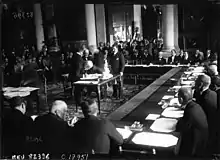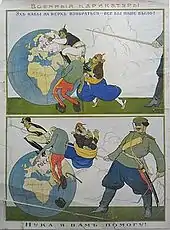Portal:World War I
The World War I PortalWorld War I or the First World War (28 July 1914 – 11 November 1918), often abbreviated as WWI, was one of the deadliest global conflicts in history. It was fought between two coalitions, the Allies and the Central Powers. Fighting occurred throughout Europe, the Middle East, Africa, the Pacific, and parts of Asia. An estimated 9 million soldiers were killed in combat, plus another 23 million wounded, while 5 million civilians died as a result of military action, hunger, and disease. Millions more died as a result of genocide, while the 1918 Spanish flu pandemic was exacerbated by the movement of combatants during the war. The first decade of the 20th century saw increasing diplomatic tension between the European great powers. This reached breaking point on 28 June 1914, when a Bosnian Serb named Gavrilo Princip assassinated Archduke Franz Ferdinand, heir to the Austro-Hungarian throne. Austria-Hungary held Serbia responsible, and declared war on 28 July. Russia came to Serbia's defence, and by 4 August, defensive alliances had drawn in Germany, France, and Britain, with the Ottoman Empire joining the war in November. (Full article...) Selected event –
The Battle of Verdun (French: Bataille de Verdun [bataj də vɛʁdœ̃]; German: Schlacht um Verdun [ʃlaxt ʔʊm ˈvɛɐ̯dœ̃]) was fought from 21 February to 18 December 1916 on the Western Front in France. The battle was the longest of the First World War and took place on the hills north of Verdun-sur-Meuse. The German 5th Army attacked the defences of the Fortified Region of Verdun (RFV, Région Fortifiée de Verdun) and those of the French Second Army on the right (east) bank of the Meuse. Using the experience of the Second Battle of Champagne in 1915, the Germans planned to capture the Meuse Heights, an excellent defensive position, with good observation for artillery-fire on Verdun. The Germans hoped that the French would commit their strategic reserve to recapture the position and suffer catastrophic losses at little cost to the German infantry. Poor weather delayed the beginning of the attack until 21 February but the Germans captured Fort Douaumont in the first three days. The advance then slowed for several days, despite inflicting many French casualties. By 6 March, 20+1⁄2 French divisions were in the RFV and a more extensive defence in depth had been organised. Philippe Pétain ordered there to be no retreat and that German attacks were to be counter-attacked, despite this exposing French infantry to the German artillery. By 29 March, French guns on the west bank had begun a constant bombardment of Germans on the east bank, causing many infantry casualties. The German offensive was extended to the west bank of the Meuse to gain observation and eliminate the French artillery firing over the river but the attacks failed to reach their objectives. In early May, the Germans changed tactics again and made local attacks and counter-attacks; the French recaptured part of Fort Douaumont but then the Germans ejected them and took many prisoners. The Germans tried alternating their attacks on either side of the Meuse and in June captured Fort Vaux. The Germans advanced towards the last geographical objectives of the original plan, at Fleury-devant-Douaumont and Fort Souville, driving a salient into the French defences. Fleury was captured and the Germans came within 2.5 mi (4 km) of the Verdun citadel but in July the offensive was cut back to provide troops, artillery and ammunition for the Battle of the Somme, leading to a similar transfer of the French Tenth Army to the Somme front. From 23 June to 17 August, Fleury changed hands sixteen times and a German attack on Fort Souville failed. The offensive was reduced further but to keep French troops away from the Somme, ruses were used to disguise the change. (Full article...)Selected equipment –
The Webley Revolver (also known as the Webley Top-Break Revolver or Webley Self-Extracting Revolver) was, in various designations, a standard issue service pistol for the armed forces of the United Kingdom, and countries of the British Empire and the Commonwealth of Nations, from 1887 to 1970. The Webley is a top-break revolver and breaking the revolver operates the extractor, which removes cartridges from the cylinder. The Webley Mk I service revolver was adopted in 1887 and the Mk IV rose to prominence during the Boer War of 1899–1902. The Mk VI was introduced in 1915, during wartime, and is the best-known model. Firing large .455 Webley cartridges, Webley service revolvers are among the most powerful top-break revolvers produced. The .455 calibre Webley is no longer in military service. The .38/200 Webley Mk IV variant is still in use as a police sidearm in a number of countries. With a modified, "shaved" cylinder and the use of a half moon clip, the Webley Mk VI can in theory fire the .45 ACP cartridge, However in practice standard pressure .45 ACP cartridges exceed Webley proof loads and should not be used. (Full article...)Selected quote"Our life here is truly hellish. Fortunately, my soldiers are very brave and tougher than the enemy. What is more, their private beliefs make it easier to carry out orders which send them to their death. They see only two supernatural outcomes: victory for the faith or martyrdom. Do you know what the second means? It is to go straight to heaven. There, the houris, God's most beautiful women, will meet them and will satisfy their desires for all eternity. What great happiness!"
Featured articles -Selected imagesSelected biography – Did you know...?
Major topicsThings you can doFrom the World War I task force of the Military history WikiProject:
Categories World War I World War I by country Adriatic question Aftermath of World War I Allied intervention in the Russian Civil War Military awards and decorations of World War I World War I casualties Centenary of the outbreak of World War I World War I crimes Cultural history of World War I Economic history of World War I World War I espionage Events cancelled due to World War I First World War centenary Friendly fire incidents of World War I Historiography of World War I Home front during World War I Humanitarian aid organizations of World War I Intelligence of World War I World War I legislation World War I-related lists Military equipment of World War I Military animals of World War I Military medicine in World War I Military operations of World War I Military units and formations of World War I People of World War I Politics of World War I World War I propaganda Science and technology during World War I World War I sites Transport in World War I Works about World War I World War I stubs Related portalsAssociated WikimediaThe following Wikimedia Foundation sister projects provide more on this subject:
Discover Wikipedia using portals
| ||||






























































.jpg.webp)

















.jpg.webp)











.jpg.webp)









.jpg.webp)













_after_the_1916_Easter_Rising.JPG.webp)











